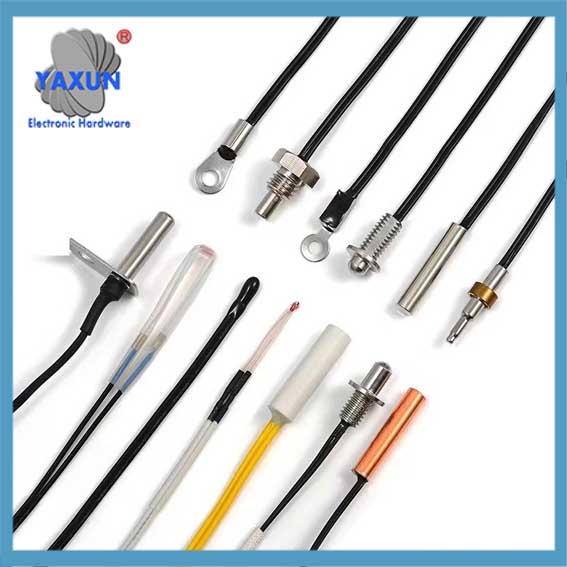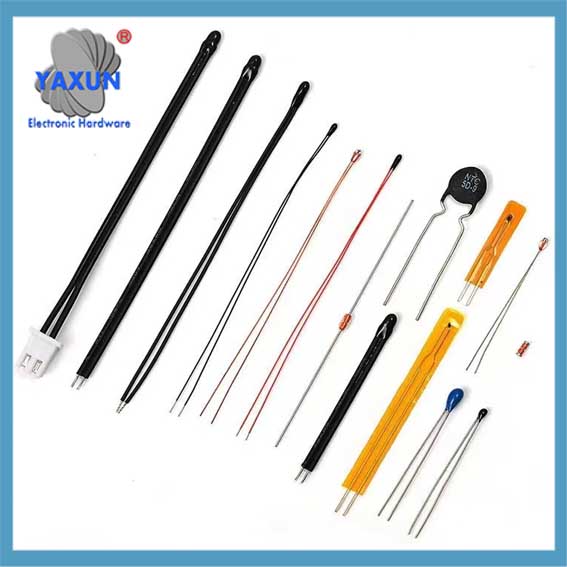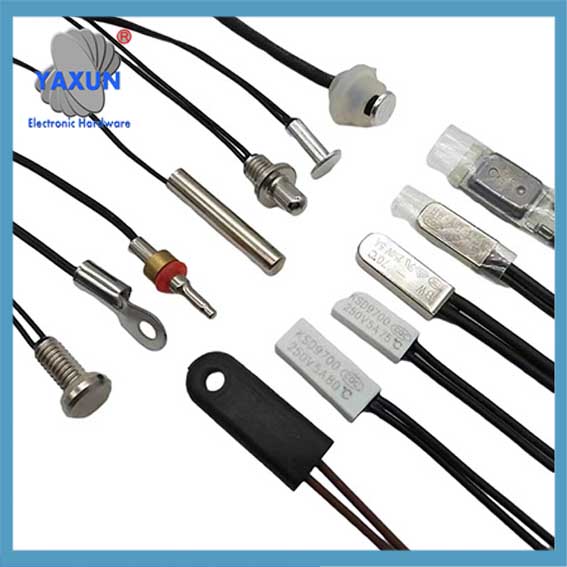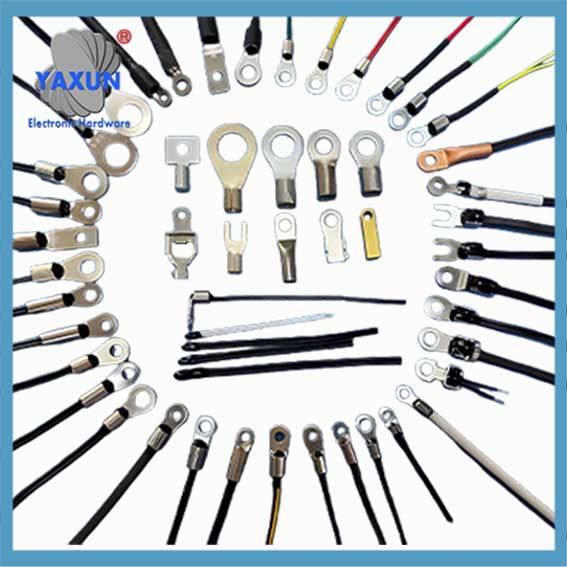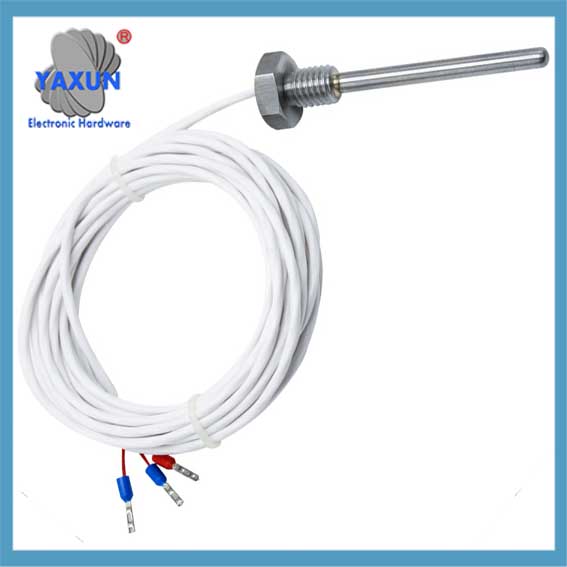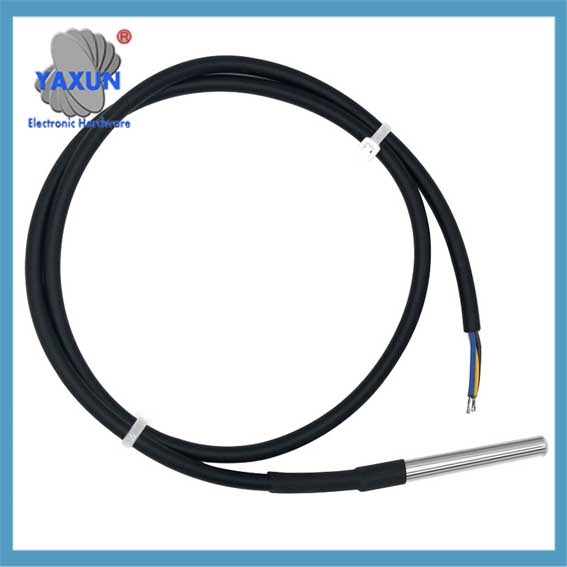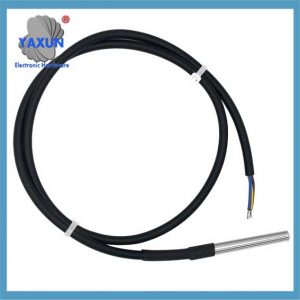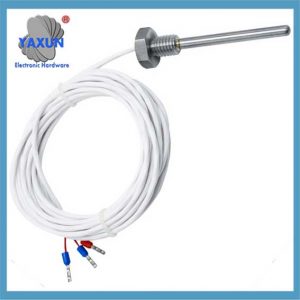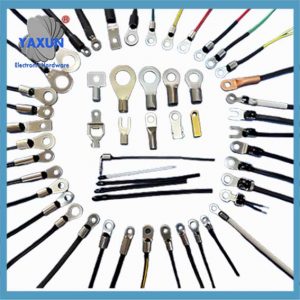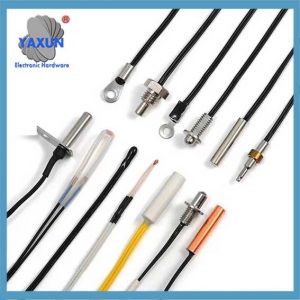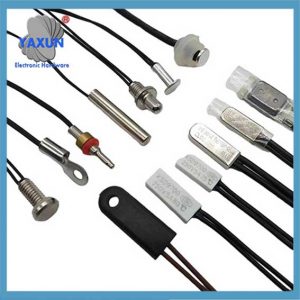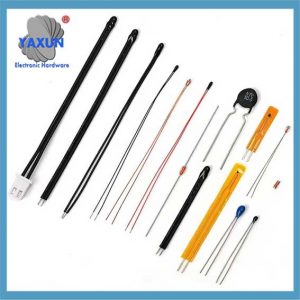Danh mục sản phẩm
- cầu chì nhiệt 32
- cầu chì gắn trên bề mặt 12
- nhiệt điện trở 36
- Giá đỡ cầu chì gắn PCB 27
- Dây nịt dây điện 6
- Giá đỡ cầu chì lưỡi 17
- máy điều nhiệt 50
- Cầu chì điện 24
- Cảm biến nhiệt độ ô tô 7
- Bộ ngắt mạch nhiệt 22
- Hộp đựng cầu chì 36
- Cảm biến nhiệt độ 75
- Công tắc nhiệt 68
- Cầu chì ô tô 20
- Cầu chì chốt xuống 8
Thẻ sản phẩm
Đầu dò nhiệt độ, Các loại cảm biến nhiệt độ & ứng dụng
Đầu dò nhiệt độ là thiết bị dùng để đo nhiệt độ, thường bao gồm một phần tử nhạy cảm và một mạch đo. Phần tử nhạy cảm có thể là cặp nhiệt điện (pt100, pt1000), một điện trở nhiệt (ntc, ptc), một chất bán dẫn (DS18B20 kỹ thuật số), vân vân., có thể chuyển đổi sự thay đổi nhiệt độ thành tín hiệu điện. Sau đó nó được khuếch đại, được lọc, đã chuyển đổi, và được xử lý bằng mạch đo, và cuối cùng một tín hiệu điện tỷ lệ thuận với nhiệt độ được phát ra.
Đầu dò nhiệt độ và cảm biến nhiệt độ là hai thiết bị khác nhau, và họ có đặc điểm riêng và kịch bản ứng dụng trong việc đo nhiệt độ.
Đầu dò nhiệt độ
MỘT “Đầu dò nhiệt độ” là một cảm biến được sử dụng để đo nhiệt độ bằng cách chuyển đổi năng lượng nhiệt thành tín hiệu điện có thể đo được, và các loại cảm biến nhiệt độ phổ biến nhất trong đầu dò bao gồm cặp nhiệt điện, Máy dò nhiệt độ điện trở (RTD), và nhiệt điện trở, mỗi người có các đặc điểm và ứng dụng riêng biệt dựa trên độ chính xác cần thiết, phạm vi nhiệt độ, và thời gian phản hồi cần thiết cho một tình huống cụ thể.
sự định nghĩa: Đầu dò nhiệt độ là thiết bị dùng để đo nhiệt độ, thường bao gồm một phần tử nhạy cảm và một mạch đo. Phần tử nhạy cảm có thể là cặp nhiệt điện (pt100, pt1000), một điện trở nhiệt (ntc, ptc), một chất bán dẫn (DS18B20 kỹ thuật số), vân vân., có thể chuyển đổi sự thay đổi nhiệt độ thành tín hiệu điện. Sau đó nó được khuếch đại, được lọc, đã chuyển đổi, và được xử lý bằng mạch đo, và cuối cùng một tín hiệu điện tỷ lệ thuận với nhiệt độ được phát ra.
Nguyên tắc làm việc: Nguyên tắc làm việc của đầu dò nhiệt độ là sử dụng phản ứng của phần tử nhạy cảm với thay đổi nhiệt độ để chuyển đổi nhiệt độ thành tín hiệu điện. Các yếu tố nhạy cảm phổ biến bao gồm cặp nhiệt điện, Điện trở nhiệt, chất bán dẫn, vân vân. Nguyên tắc làm việc của cặp nhiệt điện là sử dụng hiệu ứng nhiệt điện của hai kim loại hoặc hợp kim khác nhau. Khi chúng được kết nối với nhau và ở các nhiệt độ khác nhau, Một lực điện động tỷ lệ thuận với nhiệt độ được tạo ra. Nguyên tắc làm việc của điện trở nhiệt là sử dụng tính chất mà điện trở của vật liệu kim loại hoặc chất bán dẫn thay đổi theo nhiệt độ. Khi nhiệt độ thay đổi, Giá trị kháng thuốc cũng sẽ thay đổi cho phù hợp. Nguyên tắc làm việc của chất bán dẫn là sử dụng tính chất mà độ dẫn của vật liệu bán dẫn thay đổi theo nhiệt độ. Khi nhiệt độ thay đổi, Độ dẫn điện cũng sẽ thay đổi cho phù hợp.
kiểu: Các loại đầu dò nhiệt độ chủ yếu bao gồm các đầu dò cặp nhiệt điện, Đầu dò điện trở nhiệt, Đầu dò bán dẫn, vân vân. Đầu dò cặp nhiệt điện sử dụng cặp nhiệt điện làm yếu tố nhạy cảm, và có các đặc điểm của phạm vi đo rộng, tốc độ phản ứng nhanh, và độ chính xác cao. Đầu dò điện trở nhiệt sử dụng điện trở nhiệt làm phần tử nhạy cảm, và có các đặc điểm của độ chính xác đo cao, sự ổn định tốt, và khả năng chống can thiệp mạnh mẽ. Đầu dò bán dẫn sử dụng chất bán dẫn làm yếu tố nhạy cảm, và có các đặc điểm của kích thước nhỏ, trọng lượng nhẹ, và mức tiêu thụ năng lượng thấp.
Các trường ứng dụng: Đầu dò nhiệt độ được sử dụng rộng rãi trong ngành công nghiệp, nghiên cứu khoa học, chăm sóc y tế, Bảo vệ môi trường và các lĩnh vực khác. Chẳng hạn như đo nhiệt độ và kiểm soát trong hóa chất, Dầu khí, luyện kim, điện, Dược phẩm, Thực phẩm và các ngành công nghiệp khác.
Cáp cảm biến nhiệt độ DS18B20 có đầu dò
Dây: Màu đỏ(VCC), Màu vàng(Dữ liệu), Đen(GND)
Phạm vi nhiệt độ rộng của -55 ℃ ~ +125 oC
Cung cấp điện: 3.0V ~ 5,5V
Lời khuyên: Sử dụng điện trở 4,7k giữa dữ liệu và VCC sẽ làm cho việc thử nghiệm máy bay dễ dàng đầu dò.
Cặp nhiệt điện:
Chức năng: Tạo ra chênh lệch điện áp dựa trên nhiệt độ tại ngã ba của hai dây kim loại không giống nhau.
Ưu điểm: Phạm vi nhiệt độ rộng (-200° C đến 1750 ° C.), tương đối rẻ tiền, Thời gian phản hồi nhanh.
Nhược điểm: Độ chính xác thấp hơn so với các cảm biến khác, yêu cầu các bảng hiệu chuẩn để chuyển đổi điện áp thành nhiệt độ.
Ứng dụng: Các ứng dụng nhiệt độ cao như lò nung, Giám sát động cơ, quy trình công nghiệp.
Nhiệt kế:
Ứng dụng của đầu dò nhiệt độ:
Quy trình công nghiệp: Giám sát nhiệt độ trong các quy trình sản xuất như lò nướng, lò phản ứng, và máy đùn.
Hệ thống HVAC: Điều chỉnh nhiệt độ phòng trong các tòa nhà bằng cách theo dõi nhiệt độ không khí.
An toàn thực phẩm: Giám sát nhiệt độ thực phẩm trong quá trình nấu và lưu trữ để đảm bảo an toàn thực phẩm.
Thiết bị y tế: Đo nhiệt độ cơ thể ở bệnh nhân thông qua các đầu dò được đưa vào cơ thể.
Ngành công nghiệp ô tô: Giám sát nhiệt độ làm mát động cơ và nhiệt độ cabin.
Nghiên cứu khoa học: Các phép đo nhiệt độ chính xác trong các thí nghiệm.
Cảm biến nhiệt độ
sự định nghĩa: Cảm biến nhiệt độ là một thiết bị có thể chuyển đổi thay đổi nhiệt độ thành tín hiệu điện. Nó thường bao gồm một yếu tố nhạy cảm và mạch xử lý tín hiệu. Phần tử nhạy cảm có thể là cặp nhiệt điện, điện trở nhiệt, chất bán dẫn, vân vân. Mạch xử lý tín hiệu có thể là một mạch tương tự, một mạch kỹ thuật số, vân vân., cùng nhau hoàn thành việc mua lại, Xử lý và đầu ra của tín hiệu nhiệt độ.
Nguyên tắc làm việc: Nguyên tắc làm việc của cảm biến nhiệt độ tương tự như đầu dò nhiệt độ. Nó cũng sử dụng phản ứng của phần tử nhạy cảm với sự thay đổi nhiệt độ để chuyển đổi sự thay đổi nhiệt độ thành tín hiệu điện. Tuy nhiên, Cảm biến nhiệt độ thường có mạch xử lý tín hiệu phức tạp hơn, có thể thực hiện xử lý nâng cao hơn trên tín hiệu nhiệt độ, chẳng hạn như chuyển đổi kỹ thuật số, lưu trữ dữ liệu, giao tiếp, vân vân.
kiểu: Các loại cảm biến nhiệt độ chủ yếu bao gồm các cảm biến nhiệt độ tương tự, Cảm biến nhiệt độ kỹ thuật số, và cảm biến nhiệt độ thông minh. Cảm biến nhiệt độ tương tự đầu ra tín hiệu tương tự, cần được chuyển đổi thành tín hiệu kỹ thuật số thông qua các bộ chuyển đổi tương tự sang số. Cảm biến nhiệt độ kỹ thuật số trực tiếp tín hiệu kỹ thuật số, và có các đặc điểm của khả năng chống can thiệp mạnh mẽ, độ chính xác cao, và tích hợp dễ dàng. Cảm biến nhiệt độ thông minh có các chức năng như tự chẩn đoán, Tự hiệu chỉnh, và giao tiếp, và có thể nhận ra giám sát và kiểm soát từ xa.
đặc trưng: Cảm biến nhiệt độ có đặc điểm của độ chính xác đo cao, sự ổn định tốt, khả năng chống nhiễu mạnh mẽ, và tích hợp dễ dàng. Các loại cảm biến nhiệt độ khác nhau có các đặc điểm khác nhau, chẳng hạn như cảm biến nhiệt độ tương tự yêu cầu bộ chuyển đổi tương tự sang số, Cảm biến nhiệt độ kỹ thuật số trực tiếp tín hiệu kỹ thuật số, và các cảm biến nhiệt độ thông minh có các chức năng như tự chẩn đoán, Tự hiệu chỉnh, và giao tiếp.
Các trường ứng dụng: Cảm biến nhiệt độ được sử dụng rộng rãi trong nhà thông minh, có thể đeo thông minh, Thiết bị y tế, tự động hóa công nghiệp, Giám sát môi trường và các lĩnh vực khác, chẳng hạn như điều hòa không khí, tủ lạnh, máy giặt, Nhiệt kế, sphygmomanometer, Hệ thống kiểm soát công nghiệp, vân vân.
Cách chọn?
Khi chọn đầu dò nhiệt độ hoặc cảm biến nhiệt độ, các yếu tố sau đây cần được xem xét:
Môi trường ứng dụng: Xem xét liệu môi trường đo được có điều kiện đặc biệt như sự ăn mòn, nhiệt độ cao, áp lực cao, vân vân., Vì vậy, để chọn các vật liệu và mức độ bảo vệ phù hợp.
Phạm vi mua sắm: Chọn một cảm biến phù hợp theo phạm vi nhiệt độ cần đo để đảm bảo rằng cảm biến có thể đo chính xác trong phạm vi yêu cầu.
Yêu cầu tính toán: Chọn một cảm biến có độ chính xác tương ứng theo các yêu cầu chính xác của ứng dụng để đo nhiệt độ.
Ngân sách quan trọng: Chọn một cảm biến hiệu quả về chi phí theo các ràng buộc về ngân sách.
Cách sử dụng?
Khi sử dụng đầu dò nhiệt độ hoặc cảm biến nhiệt độ, Các vấn đề sau đây cần được ghi nhận:
Cài đặt: Cài đặt chính xác theo hướng dẫn cài đặt của cảm biến để đảm bảo rằng cảm biến tiếp xúc tốt với đối tượng được đo và tránh các lỗi đo do cài đặt không đúng.
Wires: Kết nối chính xác đường tín hiệu và đường nguồn của cảm biến để đảm bảo tính ổn định và độ chính xác của truyền tín hiệu.
sự định cỡ: Hiệu chỉnh cảm biến thường xuyên để đảm bảo rằng độ chính xác đo lường của nó đáp ứng các yêu cầu của ứng dụng.
BẢO TRÌ: Làm sạch và duy trì cảm biến thường xuyên để tránh bụi, bụi bẩn, vân vân. ảnh hưởng đến hiệu suất đo của cảm biến.
Cảm biến thăm dò nhiệt độ là một trong những sản phẩm quan trọng của công ty yxaun của chúng tôi. Chúng tôi tập trung vào các lĩnh vực sản xuất thông minh và tự động hóa công nghiệp, và cung cấp một loạt các thiết bị đo lường và đo lường ổn định cao và ổn định, bao gồm các cảm biến đầu dò nhiệt độ. Các cảm biến thăm dò nhiệt độ của chúng tôi được sử dụng rộng rãi trong sản xuất công nghiệp, Giám sát môi trường, Quản lý năng lượng và các ngành công nghiệp khác có độ chính xác cao của họ, sự ổn định và khả năng thích ứng với môi trường phức tạp. Nếu bạn có nhu cầu hoặc câu hỏi cụ thể về cảm biến thăm dò nhiệt độ của chúng tôi, Xin vui lòng tham khảo ý kiến chúng tôi. Chúng tôi sẽ hết lòng cung cấp cho bạn câu trả lời và dịch vụ chuyên nghiệp. Bạn muốn biết khía cạnh nào của cảm biến đầu dò nhiệt độ?
Cách chọn cảm biến đầu dò nhiệt độ phù hợp?
Khi chọn cảm biến đầu dò nhiệt độ, Xem xét phạm vi đo nhiệt độ, yêu cầu về độ chính xác, Tốc độ phản hồi và môi trường cài đặt. Ví dụ, cặp nhiệt điện hoặc kháng bạch kim có thể được chọn cho môi trường công nghiệp, PT100 cho độ chính xác cao, và cặp nhiệt điện để đáp ứng nhanh.
Liên hệ với chúng tôi
Đang chờ email của bạn, chúng tôi sẽ trả lời bạn trong vòng 12 giờ với thông tin có giá trị bạn cần.
 English
English Afrikaans
Afrikaans العربية
العربية বাংলা
বাংলা bosanski jezik
bosanski jezik Български
Български Català
Català 粤语
粤语 中文(简体)
中文(简体) 中文(漢字)
中文(漢字) Hrvatski
Hrvatski Čeština
Čeština Nederlands
Nederlands Eesti keel
Eesti keel Suomi
Suomi Français
Français Deutsch
Deutsch Ελληνικά
Ελληνικά हिन्दी; हिंदी
हिन्दी; हिंदी Magyar
Magyar Bahasa Indonesia
Bahasa Indonesia Italiano
Italiano 日本語
日本語 한국어
한국어 Latviešu valoda
Latviešu valoda Lietuvių kalba
Lietuvių kalba македонски јазик
македонски јазик Bahasa Melayu
Bahasa Melayu Norsk
Norsk پارسی
پارسی Polski
Polski Português
Português Română
Română Русский
Русский Cрпски језик
Cрпски језик Slovenčina
Slovenčina Slovenščina
Slovenščina Español
Español Svenska
Svenska ภาษาไทย
ภาษาไทย Türkçe
Türkçe Українська
Українська اردو
اردو Tiếng Việt
Tiếng Việt
